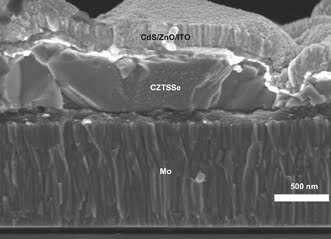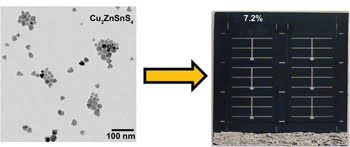Scientists at Purdue University in West Lafayette, Ind., have developed a thin-film solar cell
from Earth-abundant materials. They say that their CZTSSe solar cell, which is made
from CZTS nanocrystals, could provide a cost-friendly alternative to current thin-film
solar cells on the market.
As supplies of common rare-earth elements dwindle, the solar cell
community is forced to explore more plentiful sources from which to fabricate cells.
Qijie Guo and colleagues in the university’s Solar Energy Research Group turned
to copper, zinc, tin and sulfur for a viable solution.

Purdue University scientists
have fabricated a CZTSSe thin-film solar cell, which exhibits the large, densely
packed grains desired for high-efficiency devices. ITO = indium tin oxide. Courtesy
of the Journal of the American Chemical Society.
“Current leading thin-film technologies require rare-earth
elements, such as indium for Cu(In,Ga)(S,Se)(CIGSSe), or tellurium for CdTe,”
Guo said. “In the long run, to meet the worldwide demand for electricity,
we need elements that will not have any limitation on their availability. Also,
the relative abundance of these elements [copper, zinc, tin and sulfur] should result
in lower cost for input materials to make solar cells.”
When it comes to solar cells, efficiency is one key measure of
success. Some of the major thin-film solar cells currently available in the marketplace,
including CdTe, CIGSSe and amorphous silicon, have module efficiencies of between
8 and 12 percent. While the new CZTSSe solar cell has a total area efficiency of
just 7.2 percent, Guo points out that this is a very promising start.
“All the materials in the marketplace have been in development
for over three decades. It has taken years of research and better understanding
of the device performance that has led to their current improved performance,”
he said. “Our CZTSSe efficiency compares well with the efficiencies of the
solar cells from these materials (CdTe, CIGSSe, etc.) in their early days of development.”
And it is the method adopted by the Purdue group that really sets
it apart from other efforts in the field. Early in 2010, researchers at IBM fabricated
a similar solar cell that offered a remarkable 9.6 percent total area efficiency.
However, rather than using a vacuum-based process or the hazardous chemical hydrazine,
Guo explains that their solution phase approach is not only safer but also less
expensive.
“The efficiency of our CZTS-based solar cell is better than
the alternate technologies such as physical vapor deposition methods, and it is
second only to the IBM method, which uses toxic and unsafe hydrazine,” he
said. “Therefore, we have been successful in demonstrating the potential of
solar cells from this class of materials via an attractive and safe route.”

At left is a scanning electron microscope image of a cross section of the CZTSSe solar
cell, which demonstrates a total area efficiency of 7.2 percent (right). Courtesy
of R. Agrawal, Purdue University.
In the approach, nanocrystal inks are used in place of hydrazine-based
reactants to deposit the low-cost elements onto a glass substrate. Details of the
method are published in a paper by Qijie Guo, Grayson M. Ford, Wei-Chang Yang,
Bryce C. Walker, Eric A. Stach, Hugh W. Hillhouse and Rakesh Agrawal, appearing
in the Nov. 19, 2010, online edition of the Journal of the American Chemical Society.
Commenting on the economic viability of the CZTSSe solar cell,
Guo said: “As solar cells become even more of a commodity product, any edge
in materials or production cost becomes significant. By reducing materials cost
and supply constraints using Earth-abundant elements, CZTSSe is expected to have
a competitive advantage over thin-film materials such as CIGSSe and CdTe.”
The group has its sights set firmly on commercialization and hopes
to further improve efficiencies to more than 10 percent.
“Although it is difficult to speculate [about] the timing
of such advancement, we hope to achieve this goal in the near future,” Guo
said. “After that, the challenge will be to scale the technology from the
lab to commercial production level. Once we have achieved the desired lab-scale
efficiency, the large-scale production will probably take two to three years.”